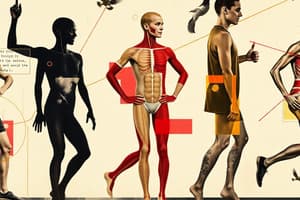Podcast
Questions and Answers
According to the FITT principle, which component refers to the type of activity performed?
According to the FITT principle, which component refers to the type of activity performed?
- Intensity
- Type (correct)
- Time
- Frequency
Which of the following is an example of a SMART goal?
Which of the following is an example of a SMART goal?
- Improve my strength
- Exercise more often
- Become healthier
- Run 5km in under 30 minutes by the end of 12 weeks (correct)
What is the recommended minimum duration of moderate-intensity aerobic physical activity per week, according to physical activity guidelines?
What is the recommended minimum duration of moderate-intensity aerobic physical activity per week, according to physical activity guidelines?
- 200 minutes
- 30 minutes
- 150 minutes (correct)
- 75 minutes
Which of the following is most directly associated with increased body composition control and insulin sensitivity?
Which of the following is most directly associated with increased body composition control and insulin sensitivity?
Which of the following is a modifiable factor that, when addressed, can reduce the risk of premature mortality?
Which of the following is a modifiable factor that, when addressed, can reduce the risk of premature mortality?
According to the principles of exercise programming, what does 'progressive overload' refer to?
According to the principles of exercise programming, what does 'progressive overload' refer to?
What is a key disadvantage of using questionnaires to measure physical activity?
What is a key disadvantage of using questionnaires to measure physical activity?
Which of the following best describes exercise prescription?
Which of the following best describes exercise prescription?
What does the principle of 'specificity' in exercise programming primarily refer to?
What does the principle of 'specificity' in exercise programming primarily refer to?
Which tool for measuring physical activity can record and store heart rate data over an extended period?
Which tool for measuring physical activity can record and store heart rate data over an extended period?
Why is it important to consider an individual's health status before prescribing an exercise program?
Why is it important to consider an individual's health status before prescribing an exercise program?
What is the major limitation of using a pedometer to track physical activity?
What is the major limitation of using a pedometer to track physical activity?
How might a program apply the 'variety' principle?
How might a program apply the 'variety' principle?
What does understanding a client's 'physiological age' provide that chronological age does not?
What does understanding a client's 'physiological age' provide that chronological age does not?
What consideration is most important when prescribing exercises for individuals with medical conditions?
What consideration is most important when prescribing exercises for individuals with medical conditions?
What is the primary benefit of understanding sources of energy and steady-state exercise in exercise physiology?
What is the primary benefit of understanding sources of energy and steady-state exercise in exercise physiology?
An individual new to exercise is not meeting the minimum physical activity guidelines, what advice should be given?
An individual new to exercise is not meeting the minimum physical activity guidelines, what advice should be given?
The effects of training are reversible if an individual reduces or stops training, which principle is this?
The effects of training are reversible if an individual reduces or stops training, which principle is this?
What is a key factor affecting the musculoskeletal and cardiorespiratory systems?
What is a key factor affecting the musculoskeletal and cardiorespiratory systems?
Which of the following metrics can be obtained from subjective measures for physical activity?
Which of the following metrics can be obtained from subjective measures for physical activity?
Flashcards
Exercise Prescription
Exercise Prescription
The process of designing a recommended physical activity regime in a systematic and individualized manner.
Physical Activity Guidelines
Physical Activity Guidelines
Moderate intensity aerobic activity for at least 30 minutes, 5 times per week; or vigorous intensity aerobic activity for at least 20 minutes, 3 times per week.
FITT Principle
FITT Principle
Frequency, Intensity, Time, Type
Benefits of Exercise
Benefits of Exercise
Signup and view all the flashcards
Chronological Age
Chronological Age
Signup and view all the flashcards
Physiological Age
Physiological Age
Signup and view all the flashcards
Contraindicated Exercise
Contraindicated Exercise
Signup and view all the flashcards
SMARTS Goals
SMARTS Goals
Signup and view all the flashcards
Guideline-Based Exercise
Guideline-Based Exercise
Signup and view all the flashcards
Specificity
Specificity
Signup and view all the flashcards
Progressive Overload
Progressive Overload
Signup and view all the flashcards
Initial Levels
Initial Levels
Signup and view all the flashcards
Inter-Individual Variability
Inter-Individual Variability
Signup and view all the flashcards
Reversibility
Reversibility
Signup and view all the flashcards
Variety
Variety
Signup and view all the flashcards
Something is better than nothing
Something is better than nothing
Signup and view all the flashcards
Study Notes
Fundamentals of Exercise Description
- HSC1105 is the course code
- Melissa Brydon is the unit coordinator and lecturer, her email is [email protected]
- Tye McGann ([email protected] ), Mike Dale ([email protected] ), and Tayla Mutton ([email protected] ) are tutors
- Weekly modules are available on Sunday nights
Canvas Expectations
- Key documents include the Unit Outline and Guidelines, Unit Assessment Guide, Academic Integrity information, and Student Learning Services details
- Students should introduce themselves in the designated forum
Assessments
- The mid-semester exam is worth 20% and held on Tuesday, April 2nd during lecture time in Week 5
- The practical exam is worth 40% and is scheduled for Tuesday, May 6th and Friday, May 9th (TBC) during Week 9
- The exercise prescription program and justification are worth 40% and due Sunday, June 8th at 11:55 PM (Study Break Week)
Course Materials
- Lecture notes are usually made available ~24 hours prior
- Lecture recordings are available at the end of each week
- Revision quizzes are available on canvas
- Tutorials have provided notes
- Additional materials include recommended readings, weekly quizzes, and videos/readings
Weekly Content Overview
- Week 1: Focuses on the basic components of an exercise program and introductory exercise prescription
- Week 2: Covers tools and evaluation related to exercise
- Week 3: Covers cardiovascular testing, programming, and monitoring, along with pre-exercise screening
- Week 4: Includes muscular strength testing, programming, and monitoring
- Week 5: Is the mid semester exam week
- Week 6: Muscular Endurance
- Week 7: Speed, Agility and Power
- There is a break week
- Week 8: Focuses on evaluating muscular flexibility
- Week 9: is focused on the practical exam
- Week 10: Covers weight loss and weight gain strategies
- Weeks 11 & 12: Focuses on program evaluation and reporting and communicating with clients and other professionals
Exercise Prescription Definition
- Exercise prescription definition is a systematic and individualized design of a physical activity regime for a person
- The source of this definition is ACSM, 2021
What We Need to Know When Prescribing Exercise
- The topics to know are the knowledge of physical activity guidelines and exercise physiology
Physical Activity Guidelines
- Moderate intensity aerobic activity: Minimum 30 minutes, 5 times per week
- Vigorous intensity aerobic activity: Minimum 20 minutes, 3 times per week
- The source of these guidelines is ACSM, 2021
FITT Principle
- F = Frequency
- I = Intensity
- T = Time
- T = Type
Reality in Australia
- Only 56% of Australian adults meet the recommended physical activity guidelines
- 11 million adults are overweight
- 4.9 million adults are obese
Sedentary Behavior and Health
- Increases risk of diabetes, heart disease, cancer, and mortality
Exercise and Health
- Reduces the risk of CVD/CAD, depression, hypertension, stroke, osteoporosis, diabetes, cancer, obesity, the risk of falls, Metabolic syndrome, and improves functional health and cognitive function
Muscular Fitness and Health
- Exercise lowers the risk of CVD/CAD, physical limitations, and blood pressure
- Exercise increases body composition control, blood glucose control, and insulin sensitivity.
Knowledge of Exercise Physiology
- Measuring and quantifying exercise is a base to exercise prescription
- This can include heart rate, VO2, sources of energy, steady state exercise and METs
Chronological vs Physiological Age
- Chronological age is the number of years since birth
- Physiological age considers biological factors like well-being, fitness level, and health status
Health Status
- Exercise may be contraindicated for individuals with certain diseases or medical conditions
- Musculoskeletal and cardiorespiratory health issues can cause participants to drop out of programs
- If there is any doubt about the health status of a participant, they should undergo a comprehensive medical examination
Current Physical Activity levels
- Associations between levels and diseases like heart disease and diabetes can be tracked
Subjective Measures of Physical Activity - Diary
- Suitable for large populations and is inexpensive
- Allows recording of specific activities and patterns.
- Disadvantages are large data, cooperation and motivation
Subjective Measures of Physical Activity - Questionnaire
- Suitable for large populations and patterns of behavior are not affected
- Total energy expenditure may be estimated
- Disadvantages include difficulty to recall, must be age appropriate, limited use with younger children
Objective Measures of Physical Activity - Pedometer
- Has a low to moderate expense
- They are small, lightweight and easy to use.
- Limitations: It cannot determine the intensity or pattern of activity, and cannot be used for water or cycling
Objective Measures of Physical Activity - HR Monitor
- Physiological marker that detects different intensities and records data
- Limitations include it can't determine activity type, hard to detect low intensity activity, and can be affected by external factors
Principles of Exercise Programming
- Exercise programs should be based on current guidelines and contain aerobic exercise, resistance exercise, guidelines to being less sedentary and special addition activities
- Specificity: Overload specific body parts and systems
- Progressive Overload: Safely increase intensity
- Initial Levels: The lower the levels of fitness, the greater the potential for improvement
- Inter-Individual Variability: There is variance in response to exercise
- Reversibility: Fitness gains are lost with inactivity
Goal Driven
- Specific: Goals should be clear and well-defined
- Measurable: Progress should be quantifiable
- Action-oriented: Focus on actions needed
- Realistic: Achievable given constraints
- Timely: Set within a specific timeframe
- Self-determined: Personally meaningful
Variety
- Continuing exercise can cause plateau
- Diversify exercise prescription, using range of resistance exercises
Something Is Better Than Nothing
- Some exercise is beneficial, especially for inactive individuals
This Week’s Tutorial
- Mitigating risk of excercise
- Gym induction and risk assessment
- Understanding training principles
- Increasing adherence and safety
Studying That Suits You
Use AI to generate personalized quizzes and flashcards to suit your learning preferences.





